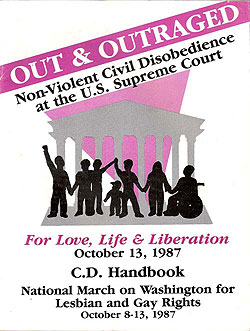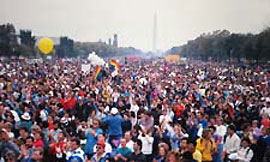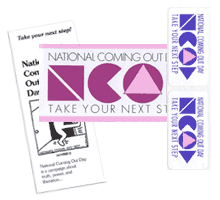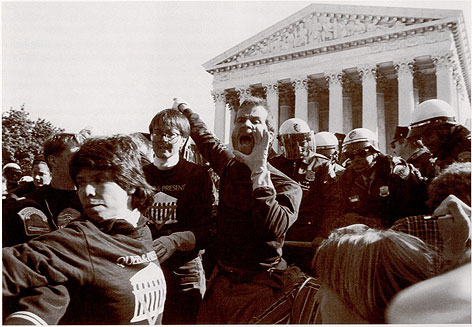 |
 |
Pro-family activism that makes a difference! | ||||
|
Kevin Jennings: Radicalized at 1987 "Gay March on Washington"Inspired Jennings to push homosexual agenda in schoolViolent demonstration in front of US Supreme Court two days laterPOSTED: Jan 7 2010by Amy Contrada, MassResistance © 2010 "Safe Schools Czar" Kevin Jennings participated in the 1987 "Gay March on Washington" and demonstrated in front of the White House and US Supreme Court, according to a book he wrote. The march is also considered to be the beginning of "National Coming Out Day," now pushed in schools across the country. At that time Jennings was a teacher at Concord Academy, a private high school in Concord, Massachusetts. Jennings was inspired by this D.C. experience to become a radical activist in the schools, he wrote. He realized the power he had over his students, and decided he had to “come out” to them. That, after all, was what the gay rights march had told everyone to do at that first national “coming out” event on October 11, 1987. Jennings tells that story in his book Mama’s Boy, Preacher’s Son (pp. 157-159): In October [1987], Bob [his “partner”] and I set off for Washington to join several hundred thousand of our closest friends in the second national march for equal rights for gay people. It’s trite to say that the experience transformed me, but it did. A half million people turned Washington into an all-gay city that weekend, kidding on the subway, holding hands on the street, defiantly and jubilantly enjoying a freedom they were rarely afforded back home in Alabama and Montana and Utah and Concord, Massachusetts. When the massive throng gathered on Sunday for the march, stretching as far as they eye could see, some contingents waited for hours before even stepping off. The high was indescribable: here we were, marching hundreds of thousands strong past the symbols of our nation. We chanted “Shame! Shame! Shame!” at the White House, a building from which we had gotten only silence and inaction as over forty thousand Americans, mainly from our community, were killed by AIDS by the end of 1987. We chanted “Shame! Shame! Shame!” at the Supreme Court, which had ruled just the year before in Bowers v. Hardwick that laws criminalizing same-sex sexual behavior were constitutional. In this case, Justice Byron White memorably wrote in the majority opinion that claims of gay activists were “facetious,” and Chief Justice Warren Burger stated in a concurring opinion that to invalidate sodomy laws would be to “cast aside a millennia of moral teaching” that was “firmly rooted in Judeo-Christian moral and ethical standards.” (Huh? I thought we had separation of church and state … gotta revise my lesson plans when I get back to Concord.) … It gave me a new sense of confidence, and I returned to Concord ever more determined to live a life of honesty. … I grew increasingly frustrated at the lack of opportunities to be honest with my students. … the atmosphere [at Concord Academy] was one that encouraged and valued innovation. But for me, the best part of the job, as always, was being able to be an important figure in so many kids’ lives. Fifty percent of the students were boarders, often living thousands of miles from home, so Concord expected its faculty to take a strong interest in their students outside of the classroom as well as within it.
|
 |
AT LEFT: SEE ALSO: |
We’ve documented Jennings’ membership in ACT UP (founded in March 1987). Was Jennings part of that rowdy protest? If he wasn’t, perhaps the weekend's activities were where he first ran into the fierce radicals he later joined up with (and celebrated just this past year at Harvard University).
Jennings begins his homosexual activism targeting schoolchildren
A few months after the march Jennings “came out” at his high school. The following year he founded and ran the Concord Academy’s pioneering GSA (gay/straight alliance), and also started his teachers’ network, GLSEN. Then, in 1992-1993, he worked with sexual radicals to establish the Massachusetts “Governor’s Commission on Gay and Lesbian Youth.”
Through that group and GLSEN, he followed through on the demands of the 1987 marchers (mentioned above) to push “AIDS education and prevention program that is explicit, culturally sensitive, lesbian and gay affirming and sex positive ... The government must provide safe sex education to all youth."
Jennings' reader for high school and college students, Becoming Visible, includes the platform of demands from the 1987 march (pp 223-224).
| Top |


